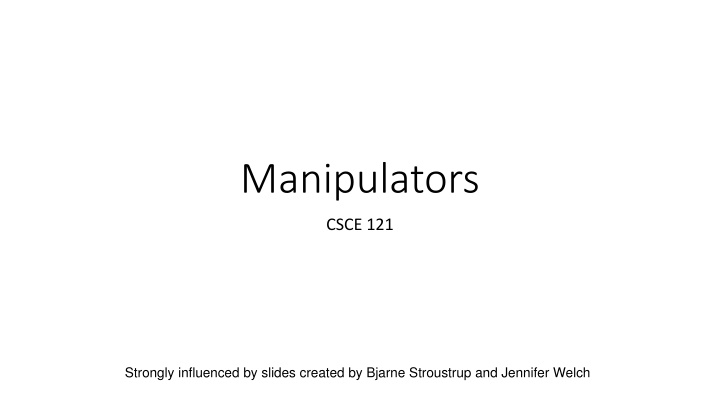Manipulators
C++ manipulators, influenced by Bjarne Stroustrup and Jennifer Welch, play a key role in modifying stream states. They allow you to control integer formatting, base indication, floating-point formatting, precision, and width of output. Learn how to utilize manipulators effectively for enhanced output in your C++ programming projects.
Download Presentation

Please find below an Image/Link to download the presentation.
The content on the website is provided AS IS for your information and personal use only. It may not be sold, licensed, or shared on other websites without obtaining consent from the author.If you encounter any issues during the download, it is possible that the publisher has removed the file from their server.
You are allowed to download the files provided on this website for personal or commercial use, subject to the condition that they are used lawfully. All files are the property of their respective owners.
The content on the website is provided AS IS for your information and personal use only. It may not be sold, licensed, or shared on other websites without obtaining consent from the author.
E N D
Presentation Transcript
Manipulators CSCE 121 Strongly influenced by slides created by Bjarne Stroustrup and Jennifer Welch
Manipulators Modify the state of a stream Most manipulators are sticky. They are set and are permanent until changed again. http://www.cplusplus.com/reference/library/manipulators/
Integer Formatting Recall Decimal (base 10: digits 0-9) Octal (base 8: digits 0-7) Hexadecimal (base 16: digits 0-9, a-f) Indicate which base an input or output stream should use: dec, oct, or hex sticky
Integer Formatting Examples int x = 1234; cout << hex; // from now on, ints will be written to screen in hex: cout << x; cin >> oct; // from now on, ints will be read in from keyboard as // if they are in octal int y; cin >> y; cout << dec; // back to decimal output cin >> dec; // back to decimal input 4
Floating Point Formatting scientific: one digit before decimal point, n digits after decimal point, plus exponent Ex: 1.2345678e+03 use manipulator scientific fixed: n digits after decimal point, no exponent Ex: 1234.567890 use manipulator fixed n is the precision (coming up next)
Precision If not set to scientific or fixed, precision is the number of digits For scientific, precision is number of digits after decimal point For fixed, precision is number of digits after decimal point Use setprecision manipulator (for output streams) Ex: cout << scientific << setprecision(8);
Width You can control the width (number of characters to be used for the output) not sticky output is never truncated to fit All this is the kind of stuff you look up when you need it




